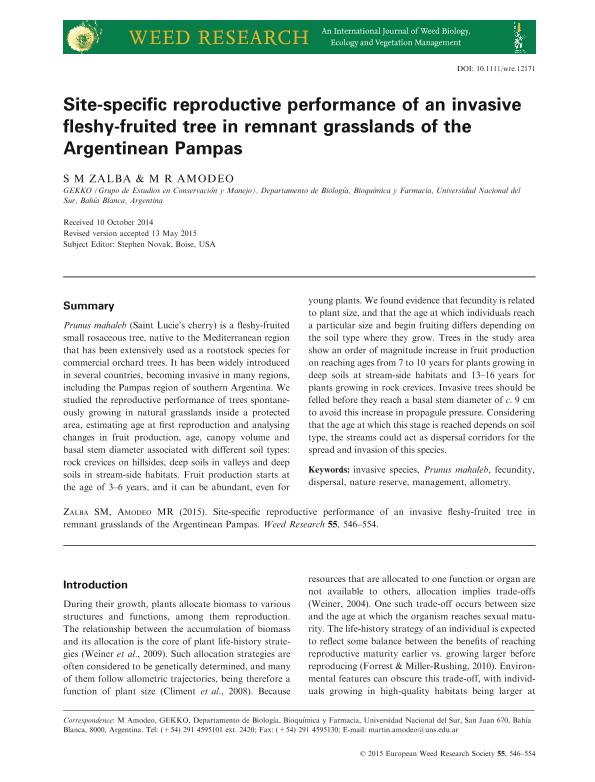Mostrar el registro sencillo del ítem
dc.contributor.author
Zalba, Sergio Martin

dc.contributor.author
Amodeo, Martín Raúl

dc.date.available
2016-12-28T17:44:11Z
dc.date.issued
2015-12
dc.identifier.citation
Zalba, Sergio Martin; Amodeo, Martín Raúl; Site-specific reproductive performance of an invasive fleshy-fruited tree in remnant grasslands of the Argentinean Pampas; Wiley Blackwell Publishing, Inc; Weed Research; 55; 6; 12-2015; 546-554
dc.identifier.issn
0043-1737
dc.identifier.uri
http://hdl.handle.net/11336/10508
dc.description.abstract
Prunus mahaleb (Saint Lucie´s cherry) is a fleshy-fruited small rosaceous tree, native to the Mediterranean region that has been extensively used as a rootstock species for commercial orchard trees. It has been widely introduced in several countries, becoming invasive in many regions, including the Pampas region of southern Argentina. We studied the reproductive performance of trees spontaneously growing in natural grasslands inside a protected area, estimating age at first reproduction and analysing changes in fruit production, age, canopy volume and basal stem diameter associated with different soil types: rock crevices on hillsides, deep soils in valleys and deep soils in stream-side habitats. Fruit production starts at the age of 3?6 years, and it can be abundant, even for young plants. We found evidence that fecundity is related to plant size, and that the age at which individuals reach a particular size and begin fruiting differs depending on the soil type where they grow. Trees in the study area show an order of magnitude increase in fruit production on reaching ages from 7 to 10 years for plants growing in deep soils at stream-side habitats and 13?16 years for plants growing in rock crevices. Invasive trees should be felled before they reach a basal stem diameter of c. 9 cm to avoid this increase in propagule pressure. Considering that the age at which this stage is reached depends on soil type, the streams could act as dispersal corridors for the spread and invasion of this species.
dc.format
application/pdf
dc.language.iso
eng
dc.publisher
Wiley Blackwell Publishing, Inc

dc.rights
info:eu-repo/semantics/openAccess
dc.rights.uri
https://creativecommons.org/licenses/by-nc-sa/2.5/ar/
dc.subject
Invasive Species
dc.subject
Prunus Mahaleb
dc.subject
Fecundity
dc.subject
Dispersal
dc.subject
Nature Reserve
dc.subject
Management
dc.subject
Allometry
dc.subject.classification
Ecología

dc.subject.classification
Ciencias Biológicas

dc.subject.classification
CIENCIAS NATURALES Y EXACTAS

dc.title
Site-specific reproductive performance of an invasive fleshy-fruited tree in remnant grasslands of the Argentinean Pampas
dc.type
info:eu-repo/semantics/article
dc.type
info:ar-repo/semantics/artículo
dc.type
info:eu-repo/semantics/publishedVersion
dc.date.updated
2016-12-27T20:28:09Z
dc.journal.volume
55
dc.journal.number
6
dc.journal.pagination
546-554
dc.journal.pais
Reino Unido

dc.journal.ciudad
Londres
dc.description.fil
Fil: Zalba, Sergio Martin. Universidad Nacional del Sur. Departamento de Biologia, Bioquimica y Farmacia. Grupo de Estudios en Conservacion y Manejo; Argentina. Consejo Nacional de Investigaciones Científicas y Técnicas; Argentina
dc.description.fil
Fil: Amodeo, Martín Raúl. Universidad Nacional del Sur. Departamento de Biologia, Bioquimica y Farmacia. Grupo de Estudios en Conservacion y Manejo; Argentina. Consejo Nacional de Investigaciones Científicas y Técnicas; Argentina
dc.journal.title
Weed Research

dc.relation.alternativeid
info:eu-repo/semantics/altIdentifier/url/http://onlinelibrary.wiley.com/doi/10.1111/wre.12171/abstract
dc.relation.alternativeid
info:eu-repo/semantics/altIdentifier/url/http://dx.doi.org/10.1111/wre.12171
Archivos asociados
